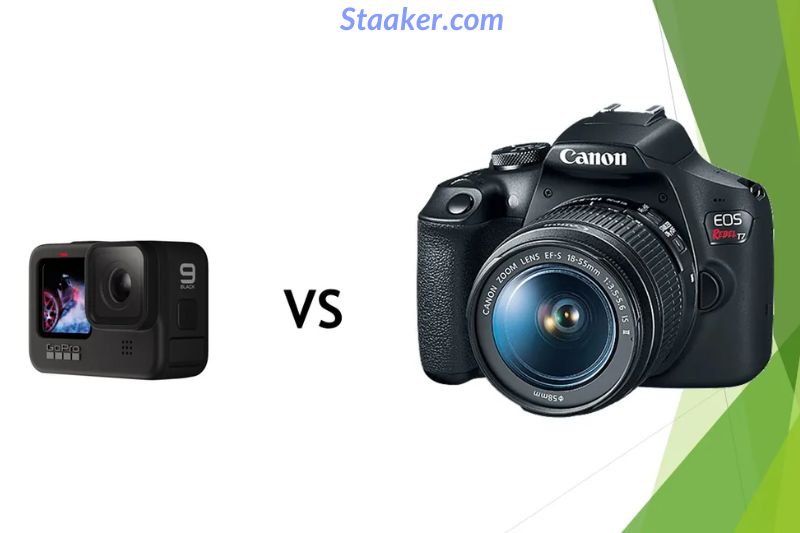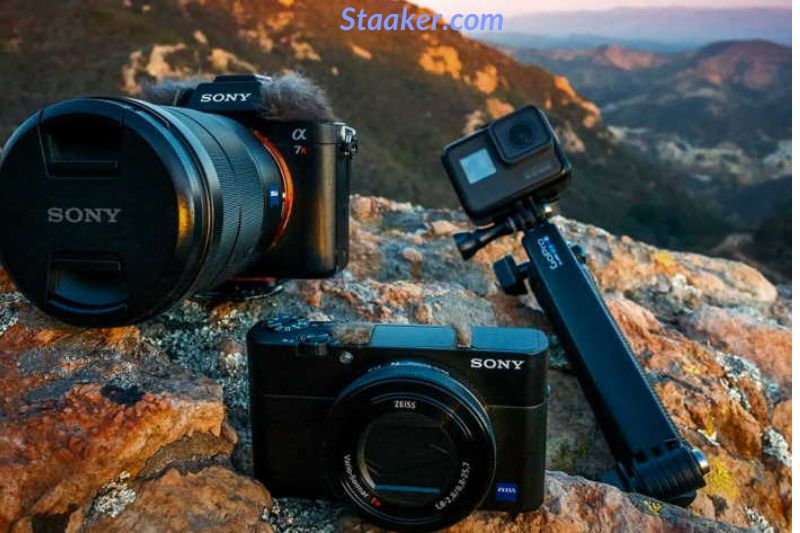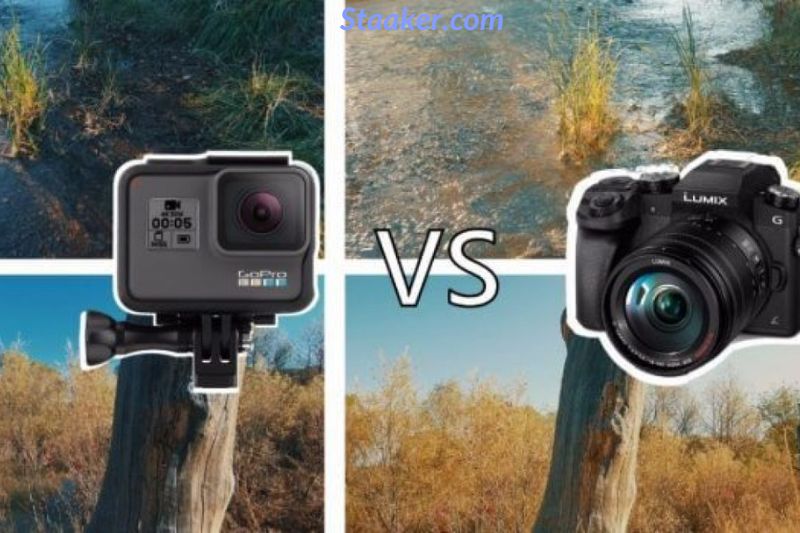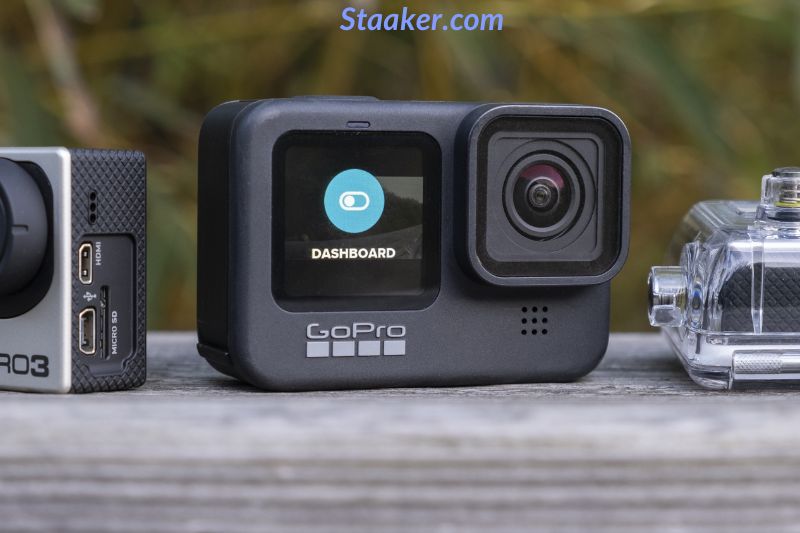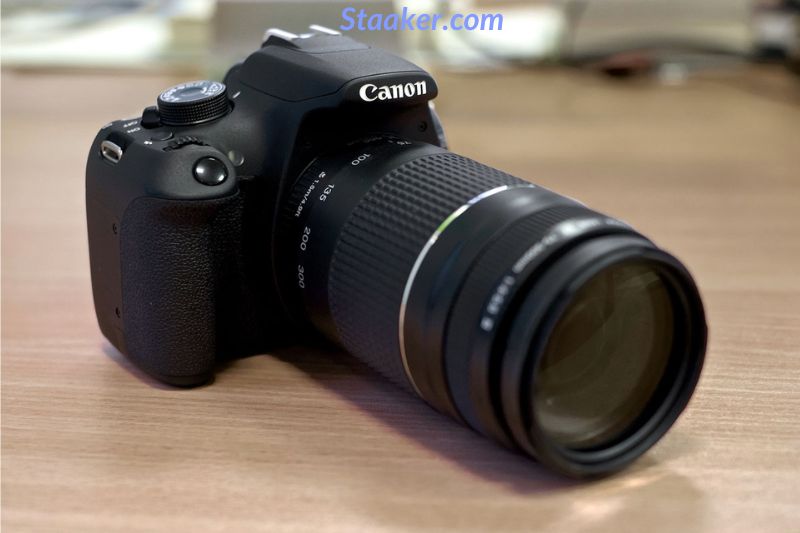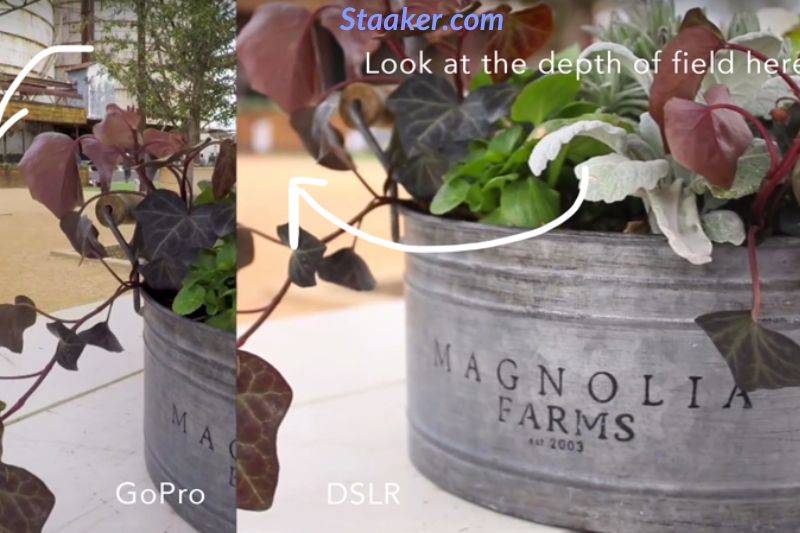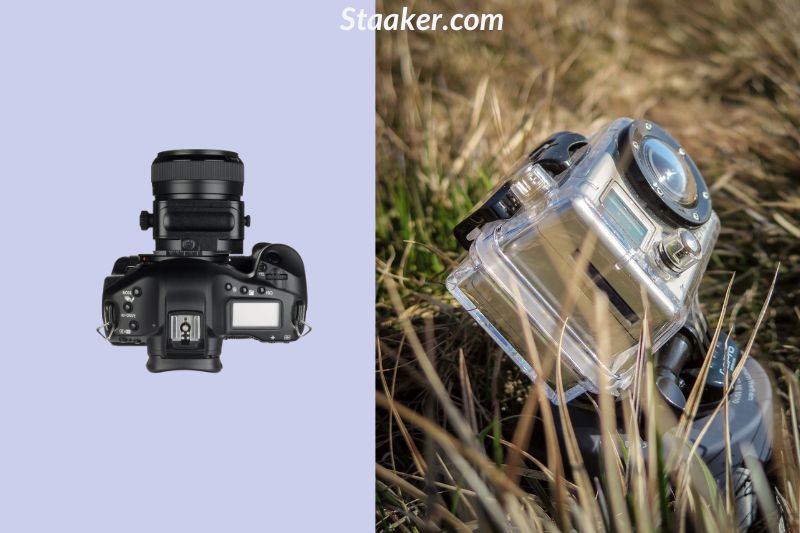When choosing between a GoPro vs DSLR camera, there are many factors to consider. Both have unique benefits that make them ideal for different situations. It depends on what you plan to use the camera for as to which one is the better choice.
Here is a quick comparison of the two types of cameras to help you decide which one is right for you.
Quality of Image
When comparing the GoPro Hero 8 to several high-quality (but reasonably priced) Nikon DSLRs, it’s easy to see how these two types of cameras differ.
The GoPro was developed and built to be a video action camera, with the ability to capture high-quality photos as a bonus. Because the GoPro sensor is half the size of the Nikon DSLR sensor, you can only capture half the image detail.
The difference in lens quality will likewise be substantial (one is tiny, the other is large and can create stunning blurred background effects, for example, as seen in portraits). However, it isn’t easy to compare because a DSLR’s lenses can be replaced while the GoPro’s cannot.
Another essential metric is ISO, with DSLRs going far higher, giving them excellent low-light image capture capacity. Of course, you’ll get some image noise at the upper end (25600), but the superior lens (wider) combined with the lower ISO means you can typically photograph handheld with no wobble with a DSLR.
GoPro vs DSLR: How To Choose The Right One
Hero 9 by GoPro
- JPEG and RAW image formats
- 20 Megapixel Sensor
- ISO range: 100-3200 (auto).
- Up to 25 photographs per second can be taken in bursts.
GoPro Hero 5 Session (Low-End)
- JPEG is one of the most popular image formats.
- 10 Megapixel Sensor (3648 x 2736)
- ISO range: 100-800 (auto).
- Up to 30 photos/second in bursts
Nikon D7200 (Mid-Range)
- JPEG and RAW image formats
- 24 Megapixel Sensor (6000 x 4000)
- ISO range: 100-25600 (auto).
- Up to 6 photographs per second can be taken in bursts.
D3400 (Nikon) (Low-End)
- JPEG and RAW image formats
- 24 Megapixel Sensor (6000 x 4000)
- ISO range: 100-25600 (auto).
- Up to 5 photographs per second can be taken in bursts.
Winner: DSLR
Video Formats
This is the point at which the game’s leaders change.
Video is the focus of the GoPro action camera. It’s also been tweaked to capture action video with the most miniature camera possible. One of the reasons this camera is so popular as a travel camera is this!
The table below shows that the GoPro supports a wide range of video codecs and frame rates. When it comes to capturing action, this is crucial.
Low frame rates will be less detailed and more difficult to work with (slow down) posts. As a result, it’s no surprise that they’re pushing frame rates (fps) to 120 in some formats.
In comparison, DLSRs rarely enter the 4K range (this is increasing recently, but only somewhat) and only go as high as 60 fps, which isn’t horrible but will be an issue for action-lovers!
In the DSLR family, getting anything good at the video will save you a lot of money unless you’re happy with 1080p at 60 frames per second.
GoPro Hero 9 (High-End)
Formats:
5K – 30/25fps, 4K – WideWide Lens @ 60, 30, 24 fps- SuperView Lens @ 30, 24 fps- Linear Lens @ 60, 30, 24 fps2.7K – WideWide Lens @ 120, 60, 30, 24 fps- SuperView Lens @ 60, 30, 24 fps- Linear Lens @ 60, 30, 24 fps- Narrow Lens @ 60, 30, 24 fps1080p – WideWide Lens @ 240, 120, 60, 30, 24 fpsSuperView Lens @ 120, 60, 30, 24 fpsLinear Lens @ 120, 60, 30, 24 fpsNarrow Lens @ 60, 30, 24 fps
GoPro Hero 5 Session (Low-End)
Image Formats: JPEG
4K @ 30, 25 fps
2.7K (2704 x 1520) @ 48, 30, 25, 24 fps
1440p (1920 x 1440) @ 60, 50, 30, 25, 24 fps
1080p (1920 x 1080) @ 90, 60, 50, 30, 25, 24 fps
960p (1280 x 960) @ 100, 60, 50, 30, 25 fps
720p (1280 x 720) @ 120, 60, 50, 30, 25 fps
Nikon D7200 (Mid-Range)
Formats:
1080p (1920 x 1080) @ 60, 50, 25, 24, 24 frames per second
720p (1280 x 720) @ 60, 50 frames per second
640 × 424 pixels at 30 frames per second (fps)
D3400 (Nikon) (Low-End)
Formats:
1080p (1920 x 1080) At 60 frames per second (1080 Full HD)
Comparison of Video Resolutions
Winner: GoPro
Video Stabilization
If you’re going to shoot a video while moving, you’ll need some stabilization.
You’ve undoubtedly seen enough “shaky” video to last a lifetime, so manufacturers are trying hard to solve the problem.
With the GoPro, you can get built-in stabilization (software-based / EIS), which has significantly improving since they first started doing it. The Hero 8 comes with a version of HyperSmooth 2.0 that is highly remarkable.
To achieve perfection, you’ll need to invest in a gimbal or a high-end camera with built-in stabilization (even better in both the body and the lens).
Neither of the DSLRs in this comparison has it, so you’ll have to pay a little more. As a result, the GoPro comes out on top in this category.
Winner: GoPro
Dimensions & Weight
This is a no-brainer, but it’s still worth mentioning: size and weight.
When compared to a conventional DSLR, GoPros are much smaller, which has several advantages:
Adaptability (you can carry them so easily although you need accessories to do so quickly)
Placement Flexibility (You can put them nearly everywhere, which is why videographers like them – hidden, on moving objects/people, selfie sticks, and so on)
Easy to carry: You don’t need to bring a big thing here; a GoPro can practically fit your pocket or bag. There is no weight, no size, and no worry.
The size difference in the photographs below is roughly this. The precise specifications can be found lower down in this section.
The weights change dramatically as well, ranging from 2.5 to 4.2 oz for a GoPro to 0.9 to 1.5 lb for our two Nikons! As a result, you should think carefully before taking your DSLR out for the day. As a result, they are better suited to professional photographers and dedicated amateurs.
Hero 8 by GoPro (High-End)
- Weight: 142 g/5 oz (with battery)
- 66.3 x 48.6 x 28.4mm Dimensions
- A session with the GoPro Hero 5 (Low-End)
- 2.6 oz. / 73 g.
- 1.49 x 1.49 x 1.42 inches in size (37.9 x 37.9 x 36.1mm)
Nikon D7200 (Mid-Range)
- 1.49-pound weight
- 5.35 x 2.99 x 4.21 inches in size (135.9 x 75.9 x 106.9mm)
- D3400 (Nikon) (Low-End)
- 0.87-pound weight
- 4.88 x 2.97 x 3.86 inches in size (124 x 75.4 x 98mm)
Winner: GoPro
Lenses
Another point worth mentioning here (which connects to the prior Image Quality debate) is the lens problem.
Because the GoPro has a small/fixed lens, it will never provide the same quality photographs as a DSLR.
A DSLR lens is more extensive, allowing more light in (along with a 24MP sensor), and offers a more excellent range of possibilities.
You can add a large zoom lens, which is terrific for getting detail or distant photos (which you couldn’t do with a GoPro).
Wide-angle lenses can also be added, which are fantastic for landscapes and action shots (and why GoPro has that built-in).
With a DSLR, you may obtain lenses with low F-stops, which are famous for allowing you to get the “blurred backdrop” look, which is popular in portrait photography. (Here’s a close-up of the blur in the black-and-white image). You may also use some excellent vintage lenses, such as the Helios, to give your pictures even more ambiance.
You’ll never get that effect with a GoPro (you may try using software that simulates it, but it won’t be the same!).
In terms of wide-angle photos, the GoPro has a few alternatives. They used to shoot wide-angle solely to offer you the most bang for your buck while moving. The GoPro Hero5 now includes options ranging from Wide to Linear (which is their way of avoiding distorting the image as much as when using a super wide-angle lens/GoPro).
These are, however, alternatives within the lens, not separate/specialized lenses that you may have on a DSLR. This, by the way, nearly always yields a better outcome and image of more excellent quality.
Winner: DSLR
See this guide to know more tips to have great photos: How To Make Your Camera Quality Better
Accessories & Versatility
It’s all about the accessories with the GoPro, especially when it comes to mounts. This refers to the capacity to wear it on anything that moves or tote it around while participating in sports, traveling, or having fun.
Below is a link to an Amazon listing for a mounting kit. It includes a chest mount, a head mount, a tripod, a swivel mount, and numerous stickies for installation on various surfaces. There’s also a three-part hand grip adjacent to it for different shooting or selfie choices.
A DSLR, on the other hand, is better suited to a typical tripod or to being draped around your neck and used as a handheld.
They’re also more concerned with image quality, so it’s no surprise that lens filters are included to assist you in achieving even better results. This might be everything from simple UV filters to ND or polarizing filters, which can help you achieve excellent results in specific situations.
Also, keep an eye out for new economical Gopro options.
Filter kits are also available for GoPros, although the selections, flexibility, and fit aren’t quite as good as they are for DSLRs. Color correction filters for underwater photography are also included, which you don’t have to bother about with a DSLR.
When it comes to external audio, it’s usually much easier to find something great for a DSLR. That isn’t to suggest the GoPro doesn’t have other possibilities. If you wish to acquire a GoPro, there are lapel mics, attached mini-boom mics, and a few other alternatives for external mics.
Winner: GOPRO
Is It Waterproof (In This Case?)
Because the GoPro was created to be a waterproof camera, there isn’t much competition in this category.
Without additional housing, the Hero5 (latest as of 2017) is now waterproof down to 33 feet (10 meters). It came with accommodation in prior versions to make it watertight, but you couldn’t control the camera via the screen.
With GoPro housing, you can travel down to 196 feet (60m).
DSLR cameras were never designed to be submerged in water. They’re pretty open and jam-packed with complicated and sensitive technology.
Some manufacturers have attempted to fix this. However, it has proven challenging due to its design.
In instances where there is a lot of water, you can get a waterproof “cover” to assist protect it (think beach, river, rain etc.). They frequently claim to be fully waterproof (even down to 16 feet), but I’m not willing to risk so much money on a cover that costs less than $50!
Instead, professional photographers use a dedicated underwater housing for their DSLR cameras.
The one displayed here is very usual for professionals, and it costs quite a bit (about one and a half G). However, this is for serious DSLR enthusiasts who have invested thousands in equipment and want that great image!
Winner: GOPRO
The simplicity of Use (For Beginners)
These cameras have a plethora of settings to experiment with, making them difficult to master.
But the big question is whether you can take it out of the box and start using it. Is it simple for a novice to take it out of the box and start using it?
It’s a piece of cake with the GoPro Hero9. There is a large red button that you press to begin shooting on the top. However, you must first ensure that you are in video or photo mode. That is the only challenging aspect. It’s also relatively simple to figure out with the new screen on the back that allows you to control everything.
When you consider all of the options, a DSLR appears to be more complicated.
On the plus side, all you have to do is set it to Auto (or video), and you’ll be fine with the default settings in most circumstances.
You’ll need to master a few more buttons (the focus, zoom, and mode dial) to get started, but it’s not that tough if you avoid the more PRO settings.
The GoPro has a slight advantage in that it appears to be simpler and less daunting, and you only need to press one button.
Winner: GOPRO
Available Controls/Settings (For The Pro)
GoPro has endeavored to include various options in their cameras, including a section called ProTune that contains more advanced features. Frame rates, wide-angle, color adjustments, and audio corrections can be customized.
But, in the end, the camera is primarily an action camera with a wide range of video resolutions and frame rates, numerous burst modes, and a built-in timer. It’s all about catching motion in this game!
Compared to a DSLR, the amount of control is weak in many areas and impossible to accomplish on the fly (you always have to go through the menus).
You can do the following with a DSLR:
- Use the LCD or viewfinder to fine-tune the lens’s focus (manual or Auto).
- All lens and shutter options can be changed (shutter speed, ISO, f-stop)
- With the buttons and dials, you can easily change modes and settings.
- Stack a bunch of high-quality filters on top of each other.
With the GoPro, it’s more of a “set and forgets” situation. If you want to adjust settings as you go, you’ll have to use the screen or the main button (which you can do on DSLRs, but they have specialized dials/buttons).
Of course, the DSLR is less capable in video circumstances since many models lack 4K or the frame rates required by many action photographers. However, as I previously stated in the image and video sections, the DSLR excels at producing high-quality images and video (at 1080p at least).
Winner: DSLR
Price & Model Alternatives
I won’t offer you special rates because they fluctuate so frequently, but I will give you a range and a comparison to get an idea of what you would pay — roughly.
As a result, the GoPro is aimed at the lower end of the market, with the Session model being exceptionally affordable. If you’re ready to tolerate a more recent trend of GoPro-like gadgets, the Yi 4K+ or Yi Lite, which are nearly identical, are also worth considering (but sometimes cheaper).
The DSLRs mentioned above aren’t the only ones available. Prices can quickly escalate, especially if you start purchasing individual lenses. As a result, it is a much more significant investment.
How Do You Decide Which Camera Is Right For You?
Because there is no simple solution to this question, I’ll try to split it into columns to help you decide. Each one contains a benefit of the camera in question:
GoPro
- Lightweight and portable (although often you need at least a simple mount)
- Built-in Video Stabilizer (less shake on the move)
- Frame rates and video formats (more options for action)
- Right out of the box, it’s waterproof (Hero5)
- There are numerous beautiful attachments for use in various activity settings (vehicle, bike, dive, swim, surf, walk/run/hike, and so on).
DSLR
- Picture and video quality (excellent for 1080p and tripod situations)
- Options for lenses (quality images, zoom, blurred backgrounds and more)
- Image options are available (highly configurable, changeable)
Finally, the GoPro is easier to operate and carry, and it can produce excellent 4K movies in practically every setting. However, they are not professional cameras and were never intended to be. On the other hand, Pros frequently employ them as a low-cost alternative for tricky video shoots, including on the bonnet of a car in an action shot or on moving objects. They’re also perfect for hiding in plain sight.
The DSLR is the king/queen of high-resolution photography. Because the sensors are more significant, the lenses are better, and the settings are more varied, you can always get a better image.
However, this level of the environment has a severe learning curve. However, both DSLRs and GoPros feature a simple point-and-shoot auto option if you don’t want to fuss with it.
I won’t be able to cover all scenarios or answer everyone’s queries in this comparison, so please leave your thoughts in the comments section.
Maybe you need to see:
FAQs
Is the GoPro camera suitable for photography?
GoPros have a lot going for them, making them an appealing alternative to bringing your backpack for a trip. While I’m primarily interested in utilizing them for photography, their video quality is excellent for the price and size. They’re tiny and light, but they’re tough, and the image quality is excellent.
Is it still worthwhile to invest in a DSLR camera?
A DSLR camera is worth buying for 95% of photographers (including beginners and pros), but only if they have a profitable photography business. At the same time, it is not worth it for folks who like photography as a pastime.
Is it better to get a GoPro or a conventional video camera?
GoPro cameras are designed for videographers on the go and are built to be versatile. They’re ready for action and can capture fast-moving subjects and sequences almost anyplace – including underwater. On the other hand, a DSLR or mirrorless camera is more significant and less versatile.
What is it about GoPros that makes them so popular?
Thanks to its tiny size, lightweight, and durability, the GoPro is easy to wear. There are numerous wearable mounts to choose from. It can be worn on the head, chest, wrist, helmet, or mouth.
Conclusion
Ultimately, it depends on what you plan to use the camera for. If you are mainly looking for a GoPro to capture footage of your adventures or photos of your travels, then a GoPro is likely the better choice. However, if you are looking for a DSLR camera to take pictures and videos of your daily life, a DSLR is likely the better choice. Staaker.com hopes this has helped!


